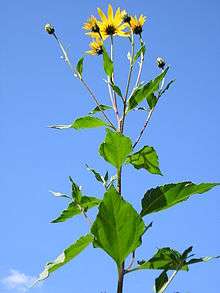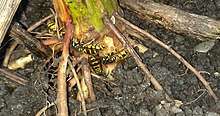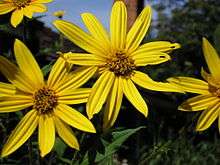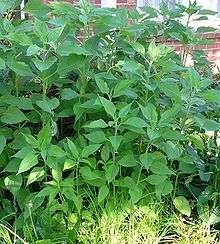Jerusalem artichoke
The Jerusalem artichoke (Helianthus tuberosus), also called sunroot, sunchoke, or earth apple, is a species of sunflower native to central North America.[2][3] It is also cultivated widely across the temperate zone for its tuber, which is used as a root vegetable.[4]
| Jerusalem artichoke | |
|---|---|
 | |
| Stem with flowers | |
 | |
| Jerusalem artichokes | |
| Scientific classification | |
| Kingdom: | Plantae |
| Clade: | Tracheophytes |
| Clade: | Angiosperms |
| Clade: | Eudicots |
| Clade: | Asterids |
| Order: | Asterales |
| Family: | Asteraceae |
| Genus: | Helianthus |
| Species: | H. tuberosus |
| Binomial name | |
| Helianthus tuberosus | |
| Synonyms[1] | |
| |
| Wikimedia Commons has media related to Jerusalem artichoke. |
Description
Helianthus tuberosus is a herbaceous perennial plant growing to 1.5–3 m (4 ft 11 in–9 ft 10 in) tall with opposite leaves on the upper part of the stem but alternate below.[5] The leaves have a rough, hairy texture. Larger leaves on the lower stem are broad ovoid-acute and can be up to 30 cm (12 in) long. Leaves higher on the stem are smaller and narrower.[6]
The flowers are yellow and produced in capitate flowerheads, which are 5–10 cm (2.0–3.9 in) in diameter, with 10–20 ray florets and 60 or more small disc florets.[6]
The tubers are often elongated and uneven, typically 7.5–10 cm (3.0–3.9 in) long and 3–5 cm (1.2–2.0 in) thick, and vaguely resembling a ginger root in appearance, with a crisp and crunchy texture when raw. They vary in colour from pale brown to white, red, or purple.[4][7]
Food use
Before the arrival of Europeans, Native Americans cultivated H. tuberosus as a food source. The tubers persist for years after being planted, so that the species expanded its range from central North America to the eastern and western regions. Early European colonists learned of this, and sent tubers back to Europe, where it became a popular crop and naturalized there. It later gradually fell into obscurity in North America, but attempts to market it commercially have been successful in the late 1900s and early 2000s.[6][8]
The tuber contains about 2% protein, no oil, and little starch. It is rich in the carbohydrate inulin (8 to 13%[9]), which is a polymer of the monosaccharide fructose. Tubers stored for any length of time convert their inulin into its component fructose. Jerusalem artichokes have an underlying sweet taste because of the fructose, which is about one and a half times as sweet as sucrose.[8]

It has also been reported as a folk remedy for diabetes[8] : since inulin is not assimilated in the intestine, it doesn't cause a spike in glycemy as potatoes would. Temperature variances have been shown to affect the amount of inulin the Jerusalem artichoke can produce. When not in tropical regions, it makes less inulin than when it is in a warmer region.[10]
Etymology

| Look up jerusalem artichoke in Wiktionary, the free dictionary. |
Despite one of its names, the Jerusalem artichoke has no relationship to Jerusalem, and it is not a type of artichoke, though the two are distantly related as members of the daisy family. The origin of the "Jerusalem" part of the name is uncertain. Italian settlers in the United States called the plant girasole, the Italian word for sunflower, because of its familial relationship to the garden sunflower (both plants are members of the genus Helianthus). Over time, the name girasole (pronounced closer to [dʒiraˈsuːlə] in southern Italian dialects) may have been changed to Jerusalem.[11] In other words, English speakers would have corrupted "girasole artichoke" (meaning, "sunflower artichoke") to Jerusalem artichoke.[12] Another explanation for the name is that the Puritans, when they came to the New World, named the plant with regard to the "New Jerusalem" they believed they were creating in the wilderness.[8] Also, various other names have been applied to the plant, such as the French or Canada potato, topinambour, and lambchoke. Sunchoke, a name by which it is still known today, was invented in the 1960s by Frieda Caplan, a produce wholesaler who was trying to revive the plant's appeal.[8]
The artichoke part of the Jerusalem artichoke's name comes from the taste of its edible tuber. Samuel de Champlain, the French explorer, sent the first samples of the plant to France, noting its taste was similar to that of an artichoke.[13][14]
The name topinambur, in one account, dates from 1615, when a member of the Brazilian coastal tribe called the Tupinambá visited the Vatican at the same time that a sample of the tuber from Canada was on display there, presented as a critical food source that helped French Canadian settlers survive the winter. The New World connection resulted in the name topinambur being applied to the tuber, the word now used in French, German, Italian, Romanian, Russian, and Spanish.[15][16]
History
Jerusalem artichokes were first cultivated by the Native Americans long before the arrival of the Europeans; this extensive cultivation obscures the exact native range of the species.[3] The French explorer Samuel de Champlain discovered that the native people of Nauset Harbor in Massachusetts had cultivated roots that tasted like artichoke. The following year, Champlain returned to the same area to discover that the roots had a flavour similar to chard[17] and was responsible for bringing the plant back to France. Some time later, Petrus Hondius, a Dutch botanist, planted a shrivelled Jerusalem artichoke tuber in his garden at Terneuzen and was surprised to see the plant proliferate.[17] Jerusalem artichokes are so well suited for the European climate and soil that the plant multiplies quickly. By the mid-1600s, the Jerusalem artichoke had become a very common vegetable for human consumption in Europe and the Americas, and was also used for livestock feed in Europe and colonial America.[8] The French in particular were especially fond of the vegetable, which reached its peak popularity at the turn of the 19th century.[8] The Jerusalem artichoke was titled 'best soup vegetable' in the 2002 Nice Festival for the Heritage of the French Cuisine.
The French explorer and Acadia's first historian, Marc Lescarbot, described Jerusalem artichokes as being "as big as turnips or truffles", suitable for eating and taste "like chards, but more pleasant". In 1629, English herbalist and botanist, John Parkinson, wrote that the widely grown Jerusalem artichoke had become very common and cheap in London, so much so "that even the most vulgar begin to despise them". In contrast, when Jerusalem artichokes first arrived in England, the tubers were "dainties for the Queen".[17]
Lewis and Clark ate the tubers, prepared by an indigenous woman, in modern-day North Dakota.[18]
They have also been called the "Canadian truffle".[19]
Cultivation and use


Unlike most tubers, but in common with many other members of the Asteraceae (including the artichoke), the tubers store their carbohydrate as inulin (not to be confused with insulin) rather than as starch. So, Jerusalem artichoke tubers are an important source of inulin used as a dietary fiber in food manufacturing.[20]
Crop yields are high, typically 16–20 tonnes/ha for tubers, and 18–28 tonnes/ha green weight for foliage. Tubers remaining in the ground lie dormant over winter and can handle temperatures as low as -30 ° C [21]. Jerusalem artichoke also has potential for production of ethanol fuel, using inulin-adapted strains of yeast for fermentation.[4]
The tubers are used for cooking and baking in same ways in as potatoes:[22], but unlike the potato they can also be eaten raw [21]. They have a similar consistency, and in their raw form have a similar texture, but a sweeter, nuttier flavor; raw and sliced thinly, they are fit for a salad. Their inulin form of carbohydrates give the tubers a tendency to become soft and mushy if boiled, but they retain their texture better when steamed. The inulin cannot be broken down by the human digestive system[23] but it is metabolized by bacteria in the colon. This can cause flatulence and, in some cases, gastric pain. John Gerard's Herbal, printed in 1621, quotes the English botanist John Goodyer on Jerusalem artichokes:[24]
which way soever they be dressed and eaten, they stir and cause a filthy loathsome stinking wind within the body, thereby causing the belly to be pained and tormented, and are a meat more fit for swine than men.
Jerusalem artichokes have 650 mg potassium per 1 cup (150g) serving. They are also high in iron, and contain 10-12% of the US RDA of fiber, niacin, thiamine, phosphorus, and copper.[25]
Jerusalem artichokes can be used as animal feed, but they must be washed before being fed to most animals. Pigs can forage, however, and safely eat them directly from the ground. The stalks and leaves can be harvested and used for silage, though cutting the tops greatly reduces the harvest of the roots.
| Nutritional value per 100 g (3.5 oz) | |
|---|---|
| Energy | 304 kJ (73 kcal) |
17.44 g | |
| Sugars | 9.6 g |
| Dietary fiber | 1.6 g |
0.01 g | |
2 g | |
| Vitamins | Quantity %DV† |
| Thiamine (B1) | 17% 0.2 mg |
| Riboflavin (B2) | 5% 0.06 mg |
| Niacin (B3) | 9% 1.3 mg |
| Pantothenic acid (B5) | 8% 0.397 mg |
| Vitamin B6 | 6% 0.077 mg |
| Folate (B9) | 3% 13 μg |
| Vitamin C | 5% 4 mg |
| Minerals | Quantity %DV† |
| Calcium | 1% 14 mg |
| Iron | 26% 3.4 mg |
| Magnesium | 5% 17 mg |
| Phosphorus | 11% 78 mg |
| Potassium | 9% 429 mg |
| |
| †Percentages are roughly approximated using US recommendations for adults. Source: USDA Nutrient Database | |
Fermented products
In Baden-Württemberg, Germany, over 90% of the Jerusalem artichoke crop is used to produce a spirit called "Topinambur", "Topi" or "Rossler".[26] By the end of the 19th century, Jerusalem artichokes were being used in Baden to make a spirit called "Jerusalem Artichoke Brandy", "Jerusalem Artichoke", "Topi", "Erdäpfler", "Rossler", or "Borbel".
Jerusalem artichoke brandy smells fruity and has a slight nutty-sweet flavour. It is characterised by an intense, pleasing, earthy note. The tubers are washed and dried in an oven before being fermented and distilled. It can be further refined to make "Red Rossler" by adding common tormentil, and other ingredients such as currants, to produce a somewhat bitter and astringent decoction. It is used as digestif and as a remedy for diarrhea or abdominal pain.
Marketing scheme
In the 1980s, the Jerusalem artichoke also gained some notoriety when its seeds were planted by Midwestern US farmers at the prodding of an agricultural attempt to save the family farm. This effort was an attempt to teach independent farmers to raise their own food, feed, and fuel. Little market existed for the tuber in that part of the US at the time, but contacts were made with sugar producers, oil and gas companies, and the fresh food market for markets to be developed. Fructose had not yet been established as a mainstay, nor was ethanol used as a main fuel additive as it is today. The only real profit in this effort were realized by a few first-year growers (who sold some of their seed to other farmers individually as well as with the help of the company attempting this venture). As a result, many of the farmers who had planted large quantities of the crop lost money.[27][28]
References
- The Plant List, Helianthus tuberosus L.
- "Helianthus tuberosus". County-level distribution map from the North American Plant Atlas (NAPA). Biota of North America Program (BONAP). 2014. Retrieved 26 April 2019.
- "Helianthus tuberosus". Germplasm Resources Information Network (GRIN). Agricultural Research Service (ARS), United States Department of Agriculture (USDA). Retrieved 11 December 2017.
- Purdue University Center for New Crops & Plants Products: Helianthus tuberosus
- Dickinson, T.; Metsger, D.; Bull, J.; & Dickinson, R. (2004) ROM Field Guide to Wildflowers of Ontario. Toronto:Royal Ontario Museum, p. 170.
- Gibbons, Euell. 1962. Stalking the wild asparagus. David McKay, New York
- Huxley, Anthony Julian; Mark Griffiths; Margot Levy (1992). The New Royal Horticultural Society dictionary of gardening. London: Macmillan Publishers. ISBN 978-0-333-47494-5. OCLC 29360744.
- Levetin, Estelle and Karen McMahon. Plants and Society: 231. Print. 2012.
- Brkljača, J.; Bodroža-Solarov, M.; Krulj, J.; Terzić, S.; Mikić, A.; Jeromela, A. Marjanović (2014). "Quantification of Inulin Content in Selected Accessions of Jerusalem Artichoke (Helianthus tuberosus L.)". Helia. 37 (60). doi:10.1515/helia-2014-0009.
- Puangbut; et al. "Influence of planting date and temperature on inulin content in Jerusalem artichoke". Australian Journal of Crop Science: 1159–1165.
- Smith, James Edward (1807). . p. 108f.
A change, one presumes, of the Italian name Girasole Articiocco, sun-flower artichoke, as the plant was first brought from Peru to Italy, and thence propagated throughout Europe.
- Wedgwood, Hensleigh (1855). "On False Etymologies". Transactions of the Philological Society (6): 67.
- Marcelle Bienvenu, "Topinambour, or Jerusalem, or ground artichokes are a terrific pick: Cooking Creole" | NOLA.com.
- Stanley J. Kays, Stephen F. Nottingham, Biology and Chemistry of Jerusalem Artichoke: Helianthus tuberosus L., CRC Press, 2007, 496 p. (ISBN 9781420044966), p. 7.
- Handbuch des speziellen Gemüsebaus, page?
- Graham, Peter. "Chez Gram". Retrieved 17 February 2018.
- Cooke, Nathalie. Dickenson, Victoria. What's to eat? Entrees in Canadian food history. Montreal: McGill-Queen's U Press, 2010. 21-54. Print.
- Niering, William A.; Olmstead, Nancy C. (1985) [1979]. The Audubon Society Field Guide to North American Wildflowers, Eastern Region. Knopf. p. 386. ISBN 0-394-50432-1.
- Méreuze, Didier (11 July 2015). "Topinambour, ouvre-toi !". La Croix (in French). Retrieved 14 January 2016.
- Flamm G, Glinsmann W, Kritchevsky D, Prosky L, Roberfroid M (2001). "Inulin and oligofructose as dietary fiber: a review of the evidence". Crit Rev Food Sci Nutr. 41 (5): 353–62. doi:10.1080/20014091091841. PMID 11497328.
- Have you heard about Jerusalem artichokes? https://hungry-pumpkin.com/post/have-you-heard-about-jerusalem-artichokes/
-

- Peter Barham. The Science of Cooking. p. 14.
we do not possess any enzymes that are capable of breaking down larger sugars, such as raffinose etc. These three-, four-, and five-ring sugars are made by plants especially as part of the energy storage system in seeds and beans. These sugars[ cannot be broken down in the intestines, so] they travel down into the colon where various bacteria digest them - and in the process produce copious amounts of carbon dioxide gas
- Gerard's Herbal, cited in Davidson A. (1999). The Oxford Companion to Food, first edition. Oxford University Press ISBN 0-19-211579-0.
- USDA Agricultural Research Service, http://www.nal.usda.gov/fnic/foodcomp/Data//SR20/reports/sr20fg11.pdf Archived 2012-02-06 at the Wayback Machine
- C.A.R.M.E.N. e.V.: Topinambur - Energiepflanze für Biogasanlagen. In: Newsletter "nawaros" 11/2007, Straubing.
- "Jerusalem Artichoke Archived 2009-11-28 at the Wayback Machine", Commercial Vegetable Production Guides, Oregon State University The effort to save the family farm, however, was not a part of our nation's goal to control the farm market, so falsifications and inaccurate understandings forced the closure of this effort. In a phone call from then Sec. of Agriculture, John Block, it was stated, "We don't want to save the family farm, but need to eliminate a certain percentage of them". Later, a book was published,
- Joseph Anthony Amato,The Great Jerusalem Artichoke Circus: The Buying and Selling of the Rural American Dream, University of Minnesota Press, 1993, ISBN 0-8166-2345-7 ISBN 978-0-8166-2345-7
External links
- Helianthus tuberosus – Plants for a Future database
- Jerusalem artichoke – Ohio Perennial & Biennial Weed Guide
- NutritionData, Complete nutritional info.
- Purdue University Alternative Field Crops Manual: Jerusalem Artichoke